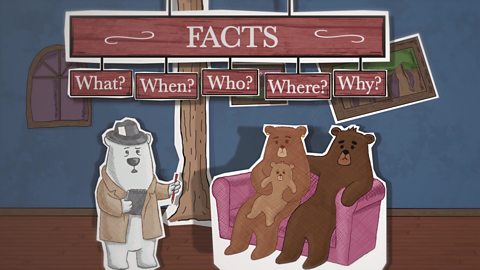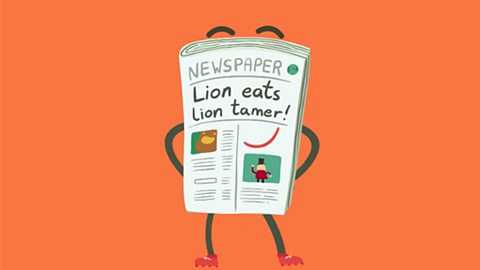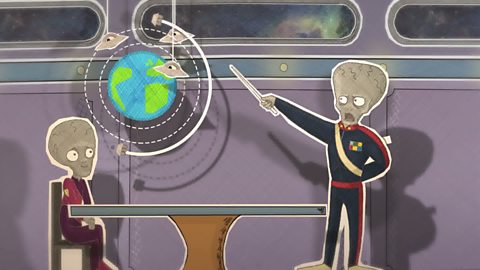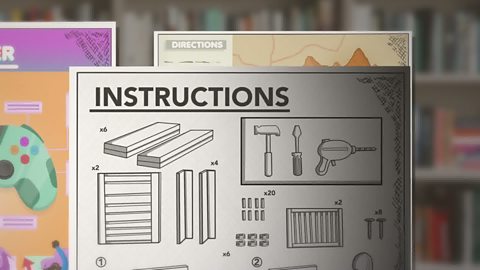Learning about setting in a story
All the top tips you need to turn your story into a newspaper article!
In this article you can find out:
- How to write a news article
- How to use facts
This resource is suitable for informative writing for P2, P3, P4, P5, P6 and P7 (First and Second Level Curriculum for Excellence).
Video - Story structure
Watch this video to learn how to write a news article.
All the top tips you need to turn your story into a newspaper article!
How to write a news article.
Whether it's local, national or international, writing articles on important events is a useful skill to learn. Where to begin when you're writing the news article?
First, you need some news. There has been a break in at this house. The only witnesses are the family.
The burglar has eaten their food and destroyed some furniture.
A good reporter will start by finding out the facts. What happened? When? Who was involved? Where? Why?
Once you have sorted all of your notes and organised the facts, you're ready to write the article.
Every good news article needs a headline. Something attention grabbing: 'Bears Blame Blonde For Burglary.'
Very nice. Everyone loves alliteration in a headline. The same letter or sound at the beginning of each word.
It then needs a subheading to provide a bit more detail about the story.
'Burglar steals porridge and destroys house in ransacking rampage.'
Your first paragraph should summarise and describe what happened as accurately as possible: 'In the early hours of this morning, a burglar broke into the home of the three bears in rural Bearwick. Police are looking for a blonde haired suspect.'
Use your notes to write additional paragraphs and give your reader more detail about what has happened.
You might want to add quotes from your witnesses, using quotation marks.
Printed newspapers have a traditional layout in columns like this.
If your news article is online, however, you won't need these.
But remember both need paragraphs and you should write in a formal way in the third person using pronouns like he, she, it or they.
A well written article will help those who know nothing about the event understand what happened.
Don't forget to add your name to the the article, but leave out your personal opinions. Stick to the facts. The what, when, who, where and why.
So that the article you write can be just right.
Where to begin
News can be:
| Type of news | Definition | Example |
|---|---|---|
| Local | Something relating to particular region or neighbourhood | A newspaper that reports on and stories events in the local community, like Paisley Daily Express, Kilmarnock Standard or Dumfries & Galloway Standard |
| National | Something relating to a single nation | A UK newspaper, like the Times or the Guardian. |
| International | Something relating to the whole world | Large news outlets, such as 91»»±¨ or CNN, that cover news around the world for a global audience. |
Where to begin when you’re writing a news article?
First you need some news!
Most news articles are about an interesting, exciting or shocking event or story.
For example
There has been a break-in at a house in the woods. The only witnesses are the family. The burglar has eaten their food and destroyed some furniture.
Can you think of an interesting or exciting story or event that you could write your report on?
Have any interesting events taking place at your school or in your local community?
Get the facts
A good reporter will start by finding out the facts. Once you have found an interesting or exciting story, start to write up some notes outlining the key facts.
Think of the five 'W' questions to help you with your fact-finding.
- What happened? For example, a burglary or a marathon event.
- When did the event take place? For example, in the morning or in the summer.
- Who was involved? For example, the burglar or runners.
- Where did it happen? For example, a house in the woods or in a busy city.
- Why did it happen? For example, someone was hungry or holding an event for charity.
Once you have sorted all your notes and organised the facts, you’re ready to write the article.
How to structure a news article
Headline
- Every good news article needs an attention grabbing headline.
- This is the heading or title at the top of an article in a newspaper, magazine or online article.
- Your headline should be short and snappy and make the reader want to find out more.
- One trick for writing a good headline is using alliterationWhen the beginning sound of words is repeated in nearby words..
Bears blame blonde for burglary
Subheading
- Your article should have a subheading to provide a bit more detail about the story.
- Subheadings are smaller than a headline and are used to break up a piece of writing into different sections.
'Burglar steals porridge and destroys house in ransacking rampage.'
First sentence
- Your first sentence should summariseTo give a brief overview of the main points of something. and describe what happened as accurately as possible.
- For example: In the early hours of this morning, a burglar broke into the home of The Three Bears in rural Bearwick. Police are looking for a blonde-haired suspect.
Paragraphs
- Paragraphs are a collection of sentences.
- They are used in writing to introduce new sections of a story, characters or pieces of information.
- Paragraphs help readers to enjoy what has been written because they break text up into easy-to-read sections.
- Use your fact-finding notes to give your reader more detail about what happened.
Quotes
- You might want to add quotes from your witnesses using quotation marks or inverted commas.
- For example: Daddy Bear said, “This wouldn’t have happened if we were pandas.”
- Find out more about using in quotation marks here: 2nd level English and Literacy: How to use inverted commas
Tone
- You should write in a formal A way of speaking or writing. In formal writing you should avoid using any words or phrases that seem casual or chatty. way.
- You should use third-person pronounPronouns take the place of nouns in a sentence. They are short words like 'it', 'she', 'he', 'you', 'we', 'they', 'us' and 'them'., like 'he', 'she', 'it' or 'they', not first-person pronouns like 'I'.
Layout
- Print newspapers and magazines usually have a traditional layout for news article called columns.
- If your news article is online, you won’t need columns but you will still need to write in paragraphsA collection of sentences used introduce new sections of a story, characters or pieces of information..
- You can include images to show what happened, places or people involved.
Don’t forget to add your name to the article but leave out your personal opinions.
Summary

Image caption, Gather facts
A good reporter will start by finding out the facts. Once you have found an interesting or exciting story, start to write up some notes outlining the key facts.
Image caption, Headline
Every good news article needs an attention grabbing headline. This is the heading or title at the top of an article in a newspaper, magazine or online article.
Image caption, Sub-heading
Subheadings are smaller than a headline and are used to break up a piece of writing into different sections.
Image caption, Paragraphs
Paragraphs are a collection of sentences. They are used in writing to introduce new sections of a story, characters or pieces of information.
Image caption, Quotes
News articles often include quotes from witnesses to give further information. Quotes should have quotation marks or inverted commas.
Image caption, Layout
Print newspapers and magazines usually have a traditional layout for news article called columns. If your news article is online, you won’t need columns but you will still need to write in paragraphs.
1 of 6
- A well-written article will help people understand what happened in an event or story.
- Stick to the facts (what, when, who, where and why) so that the article that you write can be just right.
- A good news article is structured with headings, subheadings and paragraphs.
- You will need to think about where your article is being published too. A newspaper? Magazine? Online?
Key words about structuring a story

- Sorry, something went wrongCheck your connection, refresh the page and try again. – For example: 'When he won the tennis match he became a national hero.'
- Sorry, something went wrongCheck your connection, refresh the page and try again. – For example: 'The football team had four international players.'
- Sorry, something went wrongCheck your connection, refresh the page and try again. – For example: 'The shopkeeper accurately counted out the change.'
- Sorry, something went wrongCheck your connection, refresh the page and try again. – For example: 'The suspect has dark hair, brown eyes and wears red glasses.'
- Sorry, something went wrongCheck your connection, refresh the page and try again. – For example: 'We asked who saw the car chase and three witnesses have come forward.'
- Sorry, something went wrongCheck your connection, refresh the page and try again. – For example: 'The opinion of the class was that salt and vinegar was the tastiest crisp.'
Test your knowledge
Challenge

Write your own news article
The film at the top of the page was about Goldilocks and The Three Bears.
Can you use another story you know to write a news article? You could also write about something that actually happened.
Remember:
- Start with the facts and think about: What? When? Who? Where? Why?
- If you are writing about a real event, interview people as witnesses and add their quotes. If you are writing about a fictional story, you can be creative and make these up!
- Have fun using alliteration for your headline. For example: The Ghostly Girl Glided or The Boy Brought Bananas.
More on Factual writing
Find out more by working through a topic
- count5 of 8

- count6 of 8

- count7 of 8
